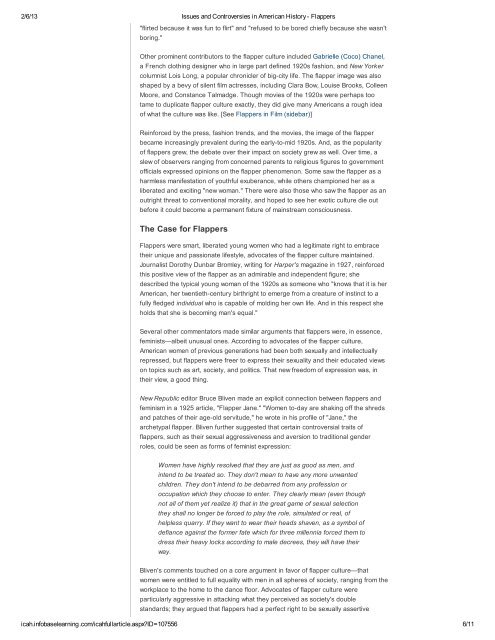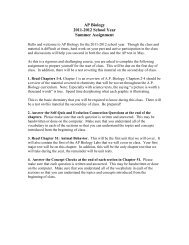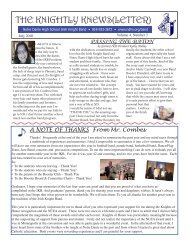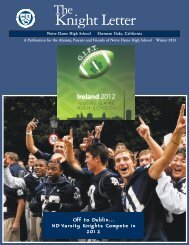Create successful ePaper yourself
Turn your PDF publications into a flip-book with our unique Google optimized e-Paper software.
2/6/13 Issues and Controversies <strong>in</strong> American History - <strong>Flappers</strong><br />
"flirted because it was fun to flirt" and "refused to be bored chiefly because she wasn't<br />
bor<strong>in</strong>g."<br />
O<strong>the</strong>r prom<strong>in</strong>ent contributors to <strong>the</strong> flapper culture <strong>in</strong>cluded Gabrielle (Coco) Chanel,<br />
a French cloth<strong>in</strong>g designer who <strong>in</strong> large part def<strong>in</strong>ed 1920s fashion, and New Yorker<br />
columnist Lois Long, a popular chronicler of big-city life. The flapper image was also<br />
shaped by a bevy of silent film actresses, <strong>in</strong>clud<strong>in</strong>g Clara Bow, Louise Brooks, Colleen<br />
Moore, and Constance Talmadge. Though movies of <strong>the</strong> 1920s were perhaps too<br />
tame to duplicate flapper culture exactly, <strong>the</strong>y did give many Americans a rough idea<br />
of what <strong>the</strong> culture was like. [See <strong>Flappers</strong> <strong>in</strong> Film (sidebar)]<br />
Re<strong>in</strong>forced by <strong>the</strong> press, fashion trends, and <strong>the</strong> movies, <strong>the</strong> image of <strong>the</strong> flapper<br />
became <strong>in</strong>creas<strong>in</strong>gly prevalent dur<strong>in</strong>g <strong>the</strong> early-to-mid 1920s. And, as <strong>the</strong> popularity<br />
of flappers grew, <strong>the</strong> debate over <strong>the</strong>ir impact on society grew as well. Over time, a<br />
slew of observers rang<strong>in</strong>g from concerned parents to religious figures to government<br />
officials expressed op<strong>in</strong>ions on <strong>the</strong> flapper phenomenon. Some saw <strong>the</strong> flapper as a<br />
harmless manifestation of youthful exuberance, while o<strong>the</strong>rs championed her as a<br />
liberated and excit<strong>in</strong>g "new woman." There were also those who saw <strong>the</strong> flapper as an<br />
outright threat to conventional morality, and hoped to see her exotic culture die out<br />
before it could become a permanent fixture of ma<strong>in</strong>stream consciousness.<br />
The Case for <strong>Flappers</strong><br />
<strong>Flappers</strong> were smart, liberated young women who had a legitimate right to embrace<br />
<strong>the</strong>ir unique and passionate lifestyle, advocates of <strong>the</strong> flapper culture ma<strong>in</strong>ta<strong>in</strong>ed.<br />
Journalist Dorothy Dunbar Bromley, writ<strong>in</strong>g for Harper's magaz<strong>in</strong>e <strong>in</strong> 1927, re<strong>in</strong>forced<br />
this positive view of <strong>the</strong> flapper as an admirable and <strong>in</strong>dependent figure; she<br />
described <strong>the</strong> typical young woman of <strong>the</strong> 1920s as someone who "knows that it is her<br />
American, her twentieth-century birthright to emerge from a creature of <strong>in</strong>st<strong>in</strong>ct to a<br />
fully fledged <strong>in</strong>dividual who is capable of mold<strong>in</strong>g her own life. And <strong>in</strong> this respect she<br />
holds that she is becom<strong>in</strong>g man's equal."<br />
Several o<strong>the</strong>r commentators made similar arguments that flappers were, <strong>in</strong> essence,<br />
fem<strong>in</strong>ists—albeit unusual ones. Accord<strong>in</strong>g to advocates of <strong>the</strong> flapper culture,<br />
American women of previous generations had been both sexually and <strong>in</strong>tellectually<br />
repressed, but flappers were freer to express <strong>the</strong>ir sexuality and <strong>the</strong>ir educated views<br />
on topics such as art, society, and politics. That new freedom of expression was, <strong>in</strong><br />
<strong>the</strong>ir view, a good th<strong>in</strong>g.<br />
New Republic editor Bruce Bliven made an explicit connection between flappers and<br />
fem<strong>in</strong>ism <strong>in</strong> a 1925 article, "Flapper Jane." "Women to-day are shak<strong>in</strong>g off <strong>the</strong> shreds<br />
and patches of <strong>the</strong>ir age-old servitude," he wrote <strong>in</strong> his profile of "Jane," <strong>the</strong><br />
archetypal flapper. Bliven fur<strong>the</strong>r suggested that certa<strong>in</strong> controversial traits of<br />
flappers, such as <strong>the</strong>ir sexual aggressiveness and aversion to traditional gender<br />
roles, could be seen as forms of fem<strong>in</strong>ist expression:<br />
Women have highly resolved that <strong>the</strong>y are just as good as men, and<br />
<strong>in</strong>tend to be treated so. They don't mean to have any more unwanted<br />
children. They don't <strong>in</strong>tend to be debarred from any profession or<br />
occupation which <strong>the</strong>y choose to enter. They clearly mean (even though<br />
not all of <strong>the</strong>m yet realize it) that <strong>in</strong> <strong>the</strong> great game of sexual selection<br />
<strong>the</strong>y shall no longer be forced to play <strong>the</strong> role, simulated or real, of<br />
helpless quarry. If <strong>the</strong>y want to wear <strong>the</strong>ir heads shaven, as a symbol of<br />
defiance aga<strong>in</strong>st <strong>the</strong> former fate which for three millennia forced <strong>the</strong>m to<br />
dress <strong>the</strong>ir heavy locks accord<strong>in</strong>g to male decrees, <strong>the</strong>y will have <strong>the</strong>ir<br />
way.<br />
Bliven's comments touched on a core argument <strong>in</strong> favor of flapper culture—that<br />
women were entitled to full equality with men <strong>in</strong> all spheres of society, rang<strong>in</strong>g from <strong>the</strong><br />
workplace to <strong>the</strong> home to <strong>the</strong> dance floor. Advocates of flapper culture were<br />
particularly aggressive <strong>in</strong> attack<strong>in</strong>g what <strong>the</strong>y perceived as society's double<br />
standards; <strong>the</strong>y argued that flappers had a perfect right to be sexually assertive<br />
icah.<strong>in</strong>fobaselearn<strong>in</strong>g.com/icahfullarticle.aspx?ID=107556 6/11

















